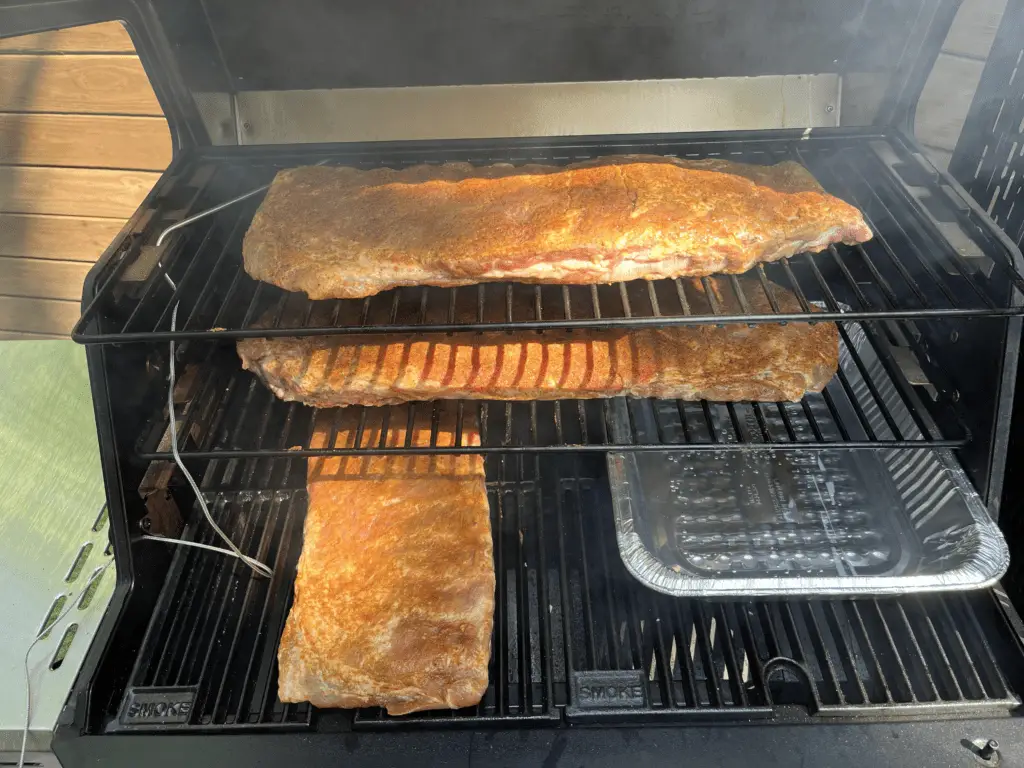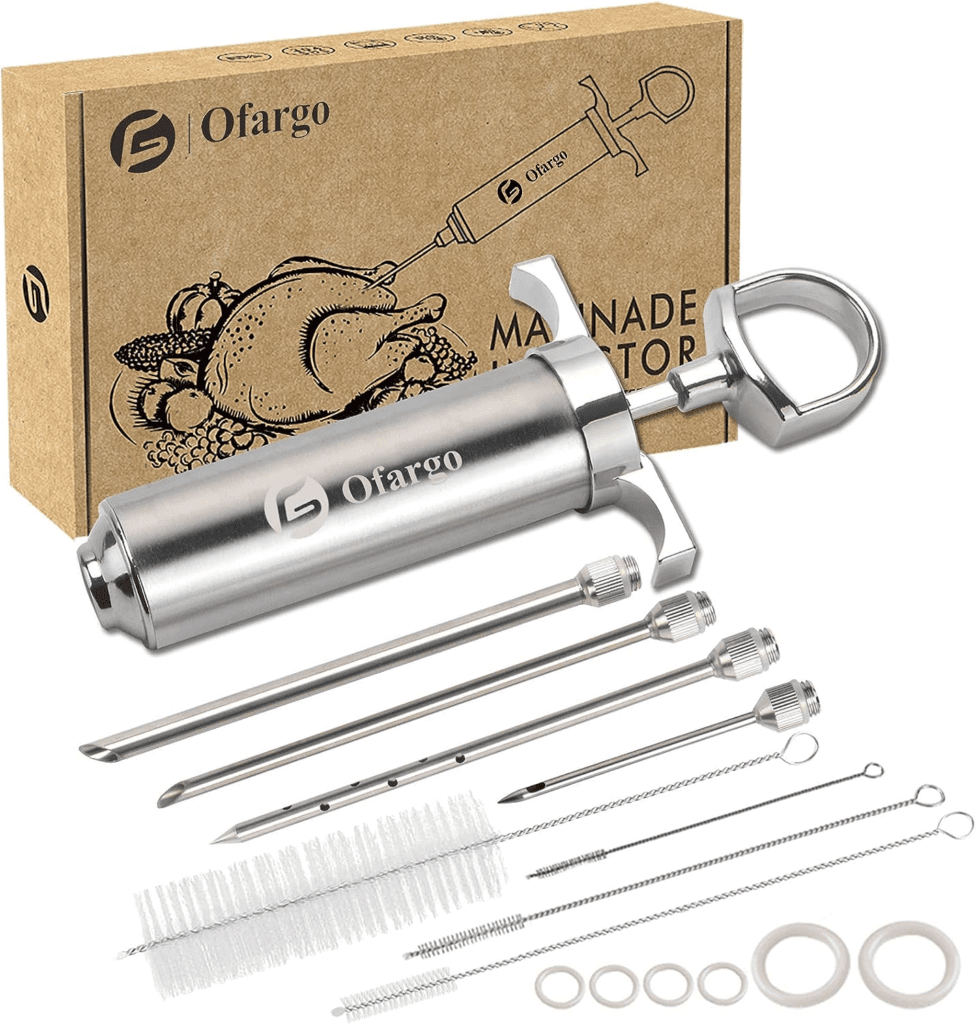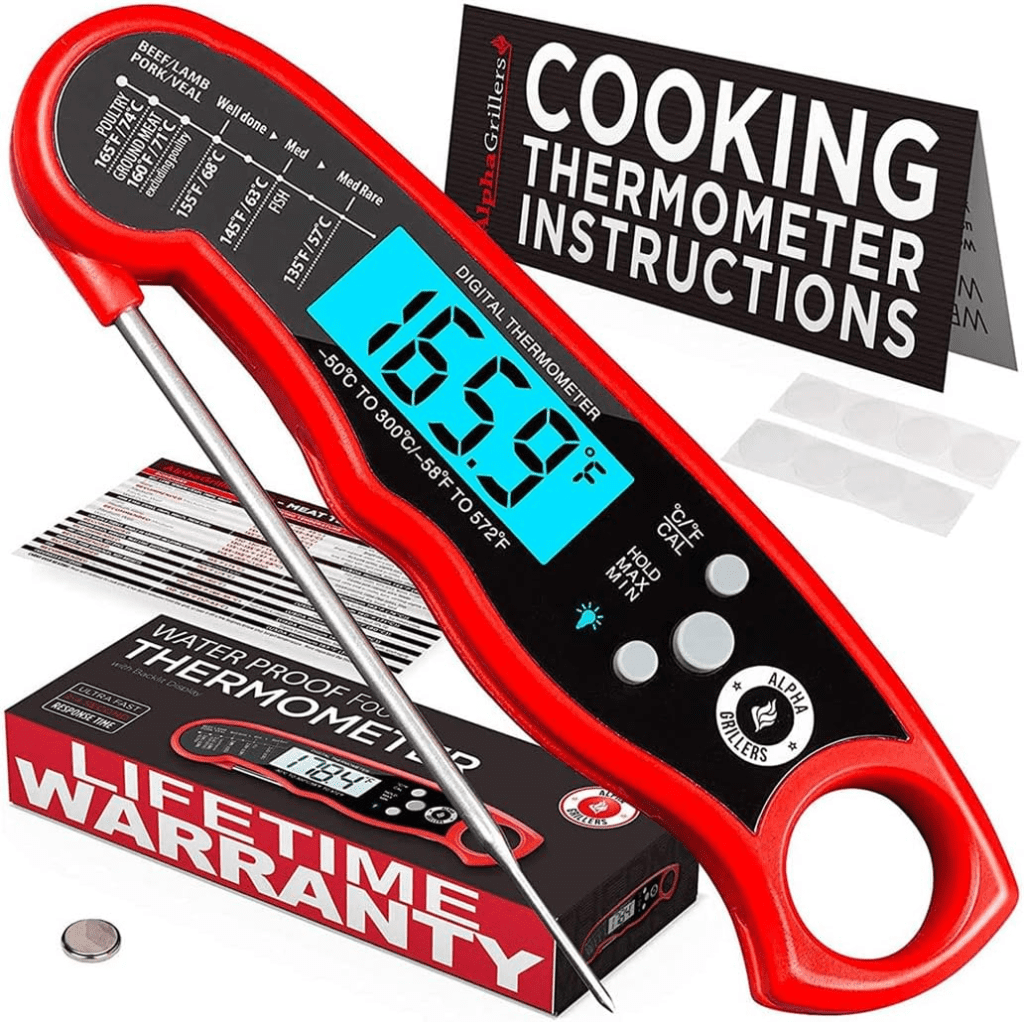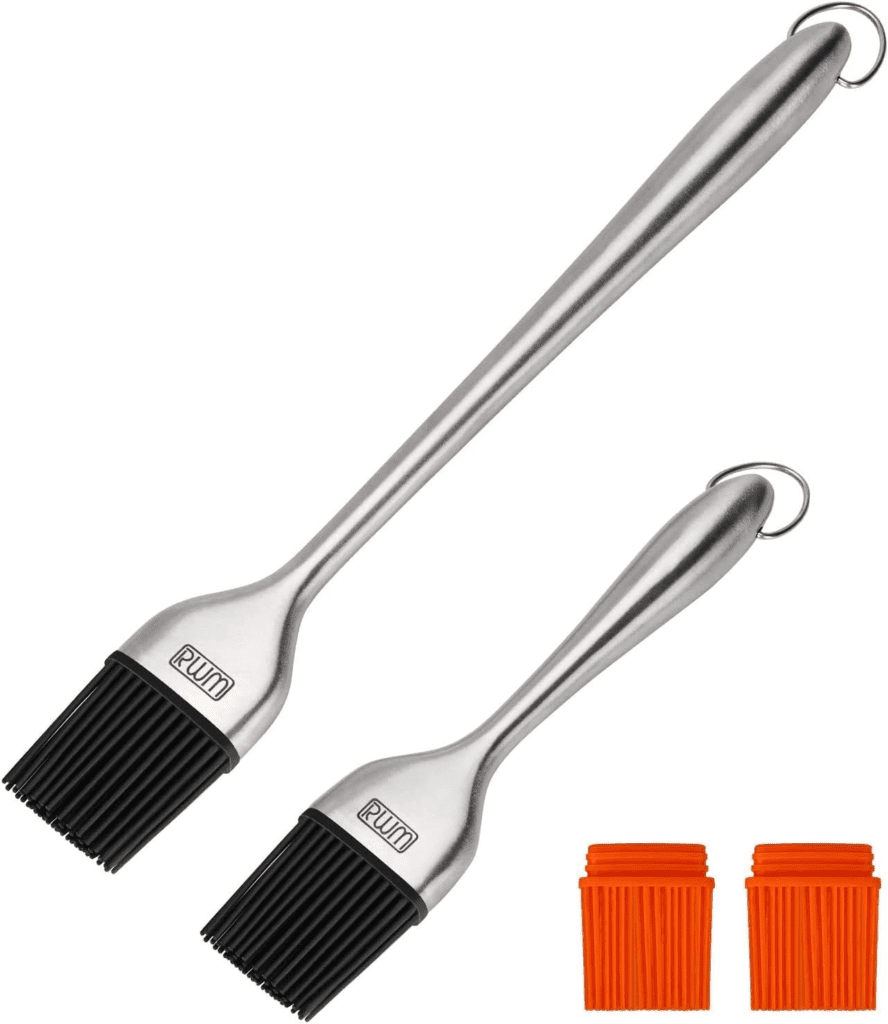Share via:
Meat smoking is a popular method of cooking that adds a unique flavor to the meat. However, smoking meat can be a tricky process, especially when it comes to keeping it moist.
Dry meat can ruin the entire cooking experience and result in a tough, chewy texture.

Fortunately, several tips and tricks can help keep the meat moist in smokers. Choosing the right cut of meat, using a dry rub or brine, and monitoring the temperature and cooking time are just a few of the ways to ensure that the meat stays juicy and tender.
So, if you are struggling with how to keep meat moist while smoking, we’ve put together some of the top tips you can follow.
16 Tips On How To Keep Meat Moist In Smokers
1- Selecting the Perfect Cut Of Meat
When preparing smoked meat, choosing the right cut is essential to make sure that it is juicy and moist.
No matter how skilled you are at seasoning or cooking techniques, starting with a sub-par cut will always yield disappointing results. That’s why investing in a quality cut of meat is essential for achieving tender, juicy, and flavorful barbecue.
While it may be tempting to opt for cheaper cuts to save money, skimping on quality can greatly impact the outcome of your smoked meat.
A good rule of thumb is to prioritize quality over price, as a superior cut will undoubtedly deliver superior results. However, this doesn’t mean you have to break the bank—there are still plenty of economical cuts of meat that can be smoked to perfection.
When selecting a cut of meat for smoking, pay close attention to the lean-to-fat ratio. Fat plays a critical role in keeping the meat moist and juicy during the smoking process.
Too lean of a cut can result in dry and tough barbecue, so it’s important to choose cuts with adequate marbling and fat content. Look for cuts with a nice balance of lean meat and intramuscular fat, as this will ensure optimal flavor and moisture retention.
What cut of meat is best to smoke?
Use this quick guide to achieve the best chance of success using a BBQ smoker.
- Best Cuts of Beef to Smoke. Chuck Roast. …
- Tri-Tip. Recommended wood pellet flavor: Hickory. …
- Prime Rib. Recommended wood pellet flavor: Cherry. …
- Beef Ribs. Recommended wood pellet flavor: Pecan. …
- Brisket. …
- Top Sirloin Steak. …
- Flank Steak. …
- Top Round Roast.
2- Brine Or Marinating Before Smoking
One of the most effective ways to keep meat moist in a smoker is to brine or marinate it beforehand. Brining meat before smoking is a tried-and-true method for enhancing moisture, tenderness, and flavor. Brining involves soaking the meat in a saltwater solution for several hours before smoking. The saltwater helps the meat retain moisture during the smoking process.
While brining you soak the meat in a saltwater solution, often flavored with herbs, spices, sugar, and aromatics, for some time before cooking.
The salt in the brine helps the meat absorb water through a process called osmosis. This extra moisture gets trapped within the muscle fibers during cooking, resulting in juicier and more succulent meat.
The salt in the brine not only helps to retain moisture but also breaks down muscle fibers, resulting in a more tender texture.
Marinating, on the other hand, involves soaking the meat in a flavorful liquid mixture that can include ingredients like vinegar, citrus juice, and herbs. This not only adds flavor to the meat but also helps it retain moisture.
When brining or marinating meat, it’s important to use the right ratio of salt or acid to liquid. Too much salt or acid can dry out the meat, while too little won’t have the desired effect. A good rule of thumb is to use around 1 tablespoon of salt or acid per cup of liquid.
3- Injecting Moisture
Injecting moisture into meat before smoking is a technique that can significantly enhance both the moisture content and flavor profile of the meat.
By using a meat injector, which resembles a large syringe with a needle attachment, you can deliver moisture-enhancing marinade solutions directly into the meat’s interior, which helps to keep the meat juicy and succulent throughout the smoking process.
To inject moisture into the meat, first prepare a solution that will enhance both moisture retention and flavor.
Common solutions include broth, marinades, melted butter, fruit juices, or a combination of these ingredients.
You can customize the solution with herbs, spices, garlic, citrus zest, or other flavorings to suit your taste preferences.
Injecting moisture into the meat allows you to add flavor and moisture deep into the muscle fibers, resulting in a juicier and more flavorful barbecue.
This technique is particularly beneficial for larger cuts of meat, such as brisket, turkey, or whole poultry, where maintaining moisture can be a challenge during the prolonged smoking process.

4- Applying a Rub to Meat before Smoking
Applying a rub to meat before smoking is a fundamental step in the barbecue process. A dry rub, consisting of a blend of herbs, spices, salt, and sometimes sugar, is massaged onto the surface of the meat.
The components of a rub work together synergistically to not only season the meat but also to draw out moisture from within, creating a flavorful and aromatic crust during the smoking process.
The salt in the rub acts as a natural brine, pulling moisture to the surface of the meat and helping to retain it throughout the cooking process.
When applying a rub, it’s essential to ensure even coverage across all sides of the meat, including any nooks and crannies. This can be achieved by gently patting the rub onto the surface of the meat, making sure to press it into any crevices for maximum flavor penetration.
In addition to traditional dry rubs, wet rubs or pastes can also be used to add flavor and moisture to the meat. These consist of a mixture of spices, herbs, and liquid ingredients such as oil, vinegar, or citrus juice, which are applied to the meat in a thick paste-like consistency.
5- Use a Water Pan
Using a water pan in your smoker is a tried-and-tested method for maintaining moisture levels and achieving tender, succulent smoked meats.
You place a water pan in the smoker. Simply fill it with water or other liquid of your choice before placing it in the smoker.
Some pitmasters like to add flavorings to the water, such as beer, apple juice, or aromatics like herbs and spices, to enhance the flavor of the meat.
The water pan serves multiple purposes in the smoking process, creating a humid environment that helps to prevent the meat from drying out while also regulating temperature fluctuations within the smoker.
The water pan acts as a barrier between the heat source and the meat, helping to moderate the temperature and create a more even cooking environment. This gentle, indirect heat helps to cook the meat slowly and evenly, allowing the natural juices to remain intact and infuse the meat with flavor.
The water pan also serves to add moisture to the smoking chamber. As the water in the pan evaporates, it creates steam, which helps to keep the air inside the smoker humid. This moisture-rich environment prevents the exterior of the meat from drying out too quickly, resulting in a moist and tender end product.
It’s important to monitor the water level in the pan throughout the smoking process and refill it as needed.
6- Spritzing or Mopping
Spritzing or mopping during the smoking process is a key technique used to maintain moisture and enhance flavor in smoked meats.
You periodically apply a liquid mixture to the surface of the meat using either a spray bottle or a mop. The liquid typically consists of water, apple juice, vinegar, or marinade, though other flavorful liquids can also be used.

The primary purpose of spritzing or mopping is to prevent the meat from drying out during the smoking process. As the meat cooks, moisture evaporates from its surface, potentially leading to dryness. By regularly spritzing or mopping the meat with a liquid, you can replenish this lost moisture, helping to keep the meat juicy and tender.
You can also adds layers of flavor to the meat by spritzing or mopping. The liquid mixture used for spritzing or mopping can be customized to complement the flavor profile of the meat and the desired result.
For example, apple juice can add sweetness and a hint of fruitiness, while vinegar can provide acidity and tanginess. Marinades can introduce additional herbs, spices, and aromatics, enhancing the overall taste of the meat.
7- Cook at Lower Temperatures
Cooking at lower temperatures for an extended period, often referred to as “low and slow” smoking, is a fundamental technique used to produce incredibly tender and flavorful meat.
By smoking the meat at lower temperatures, typically between 225°F and 275°F (107°C to 135°C), for an extended duration, you create the ideal environment for moisture retention and collagen breakdown.

During the low and slow smoking process, the natural fats and collagen within the meat gradually render and break down, resulting in a succulent and juicy texture.
Unlike high-temperature grilling, which can quickly sear the exterior of the meat and lead to moisture loss, low and slow smoking allows the meat to cook gently and evenly, ensuring that every bite is moist and packed with flavor.
The prolonged cooking time also provides ample opportunity for the smoke from the wood chips or chunks to impart a rich and complex flavor to the meat.
As the smoke circulates around the meat, it infuses it with distinctive aromas and nuances, enhancing its overall taste and character.
This isa best if you’re smoking brisket, ribs, or chicken, cooking at lower temperatures allows you to achieve barbecue perfection by maximizing moisture retention and tenderness. While it may require a bit more patience, the results are well worth the wait.
8- Texas Crutch – Wrap in Foil or Butcher Paper
Wrapping the meat in foil or butcher paper during the smoking process, often referred to as the “Texas crutch,” is a technique used to lock in moisture to enhance tenderness, particularly for large cuts such as brisket.
This method serves as a protective barrier that shields the meat from direct heat exposure, preventing it from drying out while allowing it to continue cooking to perfection.
The foil or butcher paper creates a sealed environment around the meat, trapping steam and moisture inside. This steam bath effectively bastes the meat as it cooks, keeping it moist and succulent throughout the smoking process. The barrier also helps to regulate temperature fluctuations, to ensure consistent and even cooking from edge to edge.
While both foil and butcher paper can be used for wrapping, each offers its own unique benefits. Foil provides a tighter seal and retains more moisture.
On the other hand, butcher paper allows for some airflow, which can help preserve the bark’s texture while still providing excellent moisture retention.
Pink butcher paper is usually used for smoking.

9- Tenting And Resting Period
Tenting is the process of covering the meat with aluminum foil or butcher paper to allow it to rest. The resting period is a crucial step in the smoking process that should not be overlooked. Once the meat has reached its ideal internal temperature and is removed from the smoker, it’s essential to allow it to rest before carving or serving.
This resting period allows the juices within the meat to redistribute and reabsorb, resulting in a juicier and more flavorful end product.
During the smoking process, the heat causes the juices in the meat to move towards the surface. Resting allows these juices to redistribute throughout the meat, ensuring that each bite is moist and tender. Additionally, the resting period allows the meat to relax, making it easier to carve or slice evenly.
To maximize the benefits of the resting period, it’s essential to tent the meat loosely with foil. This helps to retain heat and moisture, preventing the meat from cooling too quickly. However, it’s essential not to wrap the meat too tightly, as this can trap steam and lead to a soggy exterior.
The length of the resting period will depend on the size and type of meat being cooked. As a general rule of thumb, smaller cuts may only need a few minutes to rest, while larger cuts like brisket or pork shoulder may benefit from a longer resting period of 30 minutes to an hour.
10: Choose Moisture-Rich Wood
When choosing wood chips or chunks for smoking, opt for varieties that impart moisture during the smoking process.
Fruitwoods, such as apple and cherry, are excellent choices known for their subtle sweetness and ability to infuse moisture into the meat making them ideal for smoking poultry, pork, and seafood.
Similarly, hardwoods like hickory and oak are prized for their rich flavor profiles and moisture-retaining properties. They are popular choices for smoking beef, lamb, and game meats due to their robust flavors and long-lasting burn.
When selecting wood for smoking, it’s essential to avoid using dry or overly resinous varieties, as they can lead to dryness and impart unpleasant flavors to the meat.
Instead, opt for seasoned wood that has been properly stored and aged to ensure optimal moisture content and flavor.
Some prople also soak the wood chips or chunks in water for at least 30 minutes before adding them to the smoker. This allows the wood to absorb moisture, resulting in a slow, steady release of steam during the smoking process.
As the moistened wood smolders, it creates a humid environment inside the smoker, helping to keep the meat moist and tender.
11- Trimming and Scoring Meat
Another technique for keeping meat moist in a smoker is to trim and score it before smoking. Trimming involves removing excess fat and connective tissue from the meat, which can prevent it from drying out during smoking.
Scoring involves making shallow cuts in the surface of the meat, which can help it absorb more smoke and flavor.
When trimming and scoring meat, it’s important to be careful not to remove too much fat, as this can lead to dry, tough meat.
A good rule of thumb is to leave around 1/4 inch of fat on the meat. Additionally, it’s important to score the meat evenly, without cutting too deeply into the surface.
12- Maintain Consistent Temperature
Controlling the temperature of the smoker is important for keeping the meat moist. It is important to choose a smoker that has a temperature control feature.
Fluctuations in temperature can disrupt the cooking process, leading to unevenly cooked or dry meat. To ensure the best results, it’s essential to monitor and maintain a consistent smoking temperature throughout the entire cooking process.
Start by preheating your smoker to the desired temperature before adding the meat. This allows the smoker to reach a stable temperature and ensures that the cooking environment is consistent from the start. Once the smoker is preheated, monitor the temperature closely to prevent any fluctuations.
Electric smokers have a built-in temperature control, while charcoal and gas smokers require a separate temperature control device.
Using a reliable thermometer is key to accurately monitoring both the smoker and meat temperatures. Place the thermometer probe in the smoker near the meat to gauge the internal temperature accurately. Insert a meat thermometer into the thickest part of the meat to monitor its internal temperature throughout the cooking process.
As you smoke the meat, periodically check the smoker temperature and make any necessary adjustments to maintain consistency.
Avoid opening the smoker door unnecessarily, as this can cause heat loss and fluctuations in temperature. Instead, rely on the thermometer readings to gauge the cooking progress and adjust the smoker settings as needed.
If you notice any significant fluctuations in temperature, troubleshoot the issue promptly to prevent any adverse effects on the meat. Factors such as airflow, fuel source, and weather conditions can all impact the smoker temperature, so it’s essential to address any issues promptly to maintain consistency.

13- Managing the Smoke Density and Flow
Another important factor in keeping meat moist during smoking is managing the smoke density and flow. This can be achieved by using the right type of wood chips or chunks, and by controlling the temperature and airflow in the smoker.
It is important to avoid using too much smoke, as this can cause the meat to become bitter and dry out. It is also important to avoid using too little smoke, as this can result in a lack of flavor.
14- Baste with Butter
Basting meat with melted butter or a butter-based sauce during smoking is a very effective technique to infuse richness and moisture into your smoked dishes.
Butter has a naturally creamy and indulgent flavor profile that enhances the taste and texture of the meat while contributing to its overall juiciness.
To baste the meat with butter, start by melting the butter in a saucepan or microwave until it is fully liquefied. For added flavor, you can incorporate herbs, spices, garlic, or citrus zest into the melted butter to create a custom basting sauce that complements the flavor profile of the meat.
Once the butter is melted and seasoned to your liking, use a basting brush or spoon to generously coat the meat with the butter mixture.
Periodically baste the meat with the melted butter throughout the smoking process, typically every 30 minutes to an hour, depending on the cooking time and temperature. This frequent basting helps to replenish moisture lost during smoking and creates a flavorful crust on the exterior of the meat.
Basting also helps in a beautiful caramelized exterior, known as the bark, which adds depth of flavor and visual appeal to the finished dish.
The butter helps to promote browning and crisping, creating a mouthwatering crust that contrasts perfectly with the tender, juicy interior of the meat.

15- Slice Against the Grain
After the resting period, it is time to slice and serve the meat. When slicing, make sure to use a sharp knife and cut against the grain. This will help to keep the meat tender and juicy.
It is also important to serve the meat immediately after slicing. If you need to delay serving, keep the meat covered and warm until ready to serve.
By following these tips, you can ensure that your smoked meat stays moist and tender even after cooking.
When slicing smoked meat, always cut against the grain to shorten the muscle fibers and retain moisture. Slicing against the grain results in tender, juicy slices that are more enjoyable to eat.

16- Avoid Overcooking
Overcooking can lead to dry and tough meat. Cook the meat just until it reaches the desired internal temperature using a meat thermometer, then remove it promptly from the smoker to prevent overcooking.
Related Articles
Is Smoked Salmon Cooked Or Raw
20 Best Smoked Vegetables Recipe (EASY)
These 13 Irresistible Smoker Desserts You Should Try Today
Quick & Easy Smoked Pumpkin Pie Recipe
Frequently Asked Questions
What techniques can be used to maintain moisture in meat after it’s been smoked?
To maintain moisture in smoked meat, it’s essential to rest it for a while after smoking. This allows the juices to redistribute and settle back into the meat.
Another technique is to wrap the meat in foil or butcher paper to trap in the moisture. Adding a finishing sauce or glaze can help keep the meat moist and flavorful.
How does drying meat before smoking affect its moisture content?
Drying meat before smoking can help improve its moisture content.
Removing excess moisture from the surface of the meat, it allows the smoke to better penetrate the meat and create a flavorful crust. However, it’s important not to over-dry the meat, as this can cause it to become tough and dry.
What liquids are recommended for spritzing meat during the smoking process?
Water is the most common liquid used for spritzing meat during the smoking process. However, many pitmasters also use apple cider vinegar, apple juice, or other fruit juices to add flavor and moisture to the meat.
Are there benefits to smoking meat in a pan versus on a rack in terms of moisture retention?
Smoking meat on a rack allows the smoke to circulate the meat, which can help create a flavorful crust. However, smoking meat in a pan can help retain moisture by trapping in the juices. This can be especially useful for cuts of meat that are prone to drying out, such as chicken breasts or lean cuts of beef.
What are the best methods to prevent meat from drying out on the grill?
To prevent meat from drying out on the grill, it’s important to keep an eye on the temperature. Cooking at too high a temperature can cause the meat to dry out. Another technique is to use a meat thermometer to ensure the meat is cooked to the correct internal temperature. Basting the meat with a flavorful liquid can also help keep it moist.
I am a writer, editor, and publisher of Grillcuisines.com – an online blog dedicated to sharing grilling tips, accessories, and recipes to encourage more people to get outside and grill.
I’m off to find out the different types of grill foods, their seasons, and how to conduct outdoor cooking properly. I’ll also show you some of my grill-worthy cooking tools & accessories!


